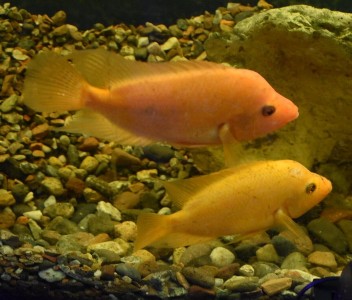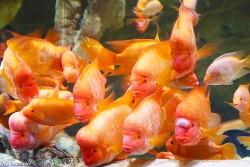Midas Cichlid Breeding
 Midas Cichlid Breeding can be challenging and most rewarding for their cichlid keepers. There are various methods of breeding Central and South American cichlids effectively. One such method would be to start out with 5 or 6 one inch Midas Cichlids and raise them together in a large aquarium typically 75 gallons or larger. This would allow for a natural pair selection to occur and it would not be uncommon to end up with two pairs utilizing this approach.
Midas Cichlid Breeding can be challenging and most rewarding for their cichlid keepers. There are various methods of breeding Central and South American cichlids effectively. One such method would be to start out with 5 or 6 one inch Midas Cichlids and raise them together in a large aquarium typically 75 gallons or larger. This would allow for a natural pair selection to occur and it would not be uncommon to end up with two pairs utilizing this approach.Various approaches to breeding Midas Cichlids really depend on their size and age. Another very common approach would be to have an adult pair to work with or at least a sexually active male and female. They could be housed in a 55 gallon aquarium divided with egg crate. Egg crate dividers are great because they are resilient to the ramming by large aggressive males and are fantastic in terms of allowing water movement and circulation thru the divider. This also increases the chances of the male’s sperm to pass thru the divider towards where the eggs are laid.
Midas Cichlids are substratum spawners; this means the females lay their eggs on a hard surface such as a piece of slate, wood, clay flower and even the aquarium glass. Males typically follow behind the female to fertilize the eggs as the female is laying them. Essentially she will lay a row of eggs and the male will pass over them and fertilize them with his sperm. This will continue until the female is finished laying her plaque of eggs which can vary depending on how gravid she is and also her size and age. Eggs can number in the high hundreds.
Back to breeding Midas Cichlids via the divider method. One variation of this approach would be to keep the pair isolated from each by the divider. This keeps the pair from lip locking and biting each other’s fins and scales. The end result with this approach is the fish remain unharmed because they are not allowed to be together; however, this can result is smaller percentages of fertilized eggs. For this to be effective the female would have to lay her eggs near the divider so as to improve the male’s changes of fertilization taking place.
Different approaches to Breeding the Midas Cichlids
The brightly colored Midas cichlid (Amphilophus citrinellus) is a popular aquarium fish cherished for its golden orange hue. While relatively easy to breed, there are a few different techniques aquarists use to achieve successful spawning and fry rearing with this species.
One method is the natural breeding approach, allowing a mature, bonded pair to spawn on their own in a dedicated tank. The male will dig out a pit in the sandy substrate to serve as the spawning site. Temperatures around 79-82°F and frequent water changes promote breeding behavior.
Another technique is through artificial conditioning using hormone injections or by altering water parameters. Lowering the pH and raising the temperature has been shown to induce spawning. The fish can then be moved to a separate tank to breed naturally.
Some breeders use tank dividers to isolate the female until she shows breeding signs like an extended ovipositor. Once ready, the divider is removed and the male is likely to spawn with her shortly after. This prevents constant harassment of the female by the aggressive male.
No matter the technique, midas cichlid parents display bi-parental care of the eggs and fry. The female primarily tends to the brood while the male defends the territory. Fry are mobile within 5-7 days and can be fed baby brine shrimp. With close attention to water quality and proper feeding, midas cichlid fry grow rapidly.
Midas cichlid food recommendation

Looks like we are out of stock for YFS carnivore sticks.
Click Here to See More Great Items on eBay!